The Japan Disaster Relief Team Makes the Grade Receiving Highest Marks in International Accreditation
2023.01.06
Japan frequently suffers from natural disasters such as typhoons and earthquakes, and its disaster response personnel have gained vast knowledge and expertise as a result. Bolstered by their experiences, the members of the Japan Disaster Relief Team (JDR) are dedicated to saving as many lives as possible through the disaster relief they provide overseas, primarily in developing countries.
Proof of their extensive capabilities came as 75 members of the JDR Search and Rescue Team recently received the highest possible certification of “Heavy” in an international assessment for rescue teams that took place from November 8 to 11, 2022, in Hyogo Prefecture. We interviewed Katsube Tsukasa, Senior Advisor in Humanitarian Assistance, JICA and certified international classifier, on the work of the JDR, the accreditation, and the training the team members undergo in order to save lives in the face of disaster.
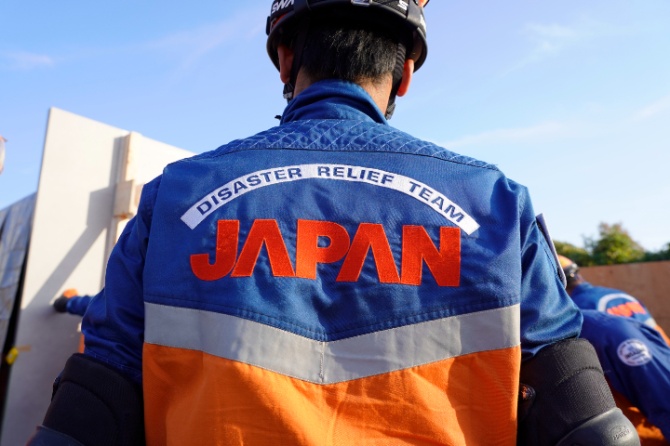
Large-scale natural disasters occur all over the world. It is difficult for developing countries, in particular, to conduct adequate rescue operations during these disasters due to their fragile economies and insufficient social infrastructure, and death tolls are high as a result. Japan, which is prone to natural disasters, launched government-based international disaster relief operations in 1979, with the intention to use the considerable experience and technical know-how to help developing nations. The Japan Disaster Relief Team (JDR) was established in 1987 and has since dispatched its members on more than 160 missions—conducting search and rescue operations for disaster victims, medical care, and consultation and advice.
“In our work, coming from a disaster-prone country, we not only value the technical aspects but also the sense of being close to the people we are helping,” says Katsube. As a member of both the United Nations Disaster Assessment and Coordination (UNDAC) team and JDR, Katsube has visited numerous disaster sites, including those of the 2013 typhoon in Leyte, Philippines, the Vanuatu cyclone and earthquake in Nepal in 2015, and the earthquake in central Mexico in 2017. “We tend to think of survivors as weak and vulnerable,” he said, “but, in fact, they understand what is most needed at the moment. It is essential for responders to listen to the needs of survivors and try to help them in any way they can. We understand this feeling on a personal level because, as Japanese people, we come from a culture that has survived many disasters.”
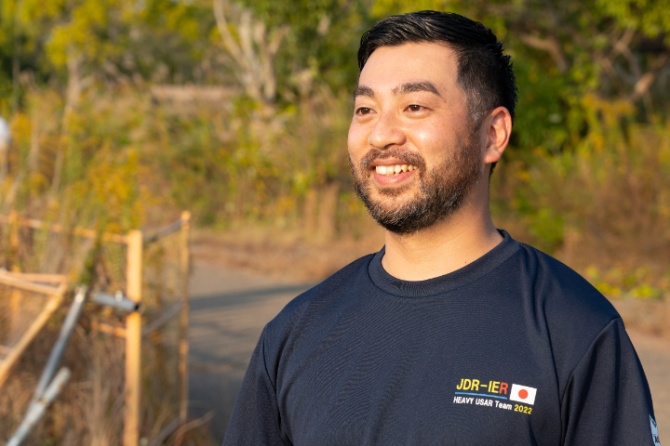
Katsube Tsukasa, JICA Senior Advisor.
JICA serves as the Secretariat of JDR, which is made up of the Rescue Team, the Medical Team, the Infectious Disease Response Team, the Expert Team, and the Japan Self-Defense Force (JSDF) Unit. The Rescue Team members are leading experts in diverse fields, including personnel from the Ministry of Foreign Affairs, the National Police Agency, the Fire and Disaster Management Agency, the Japan Coast Guard, and JICA-registered medical staff, structural assessment specialists, and operational coordinators.
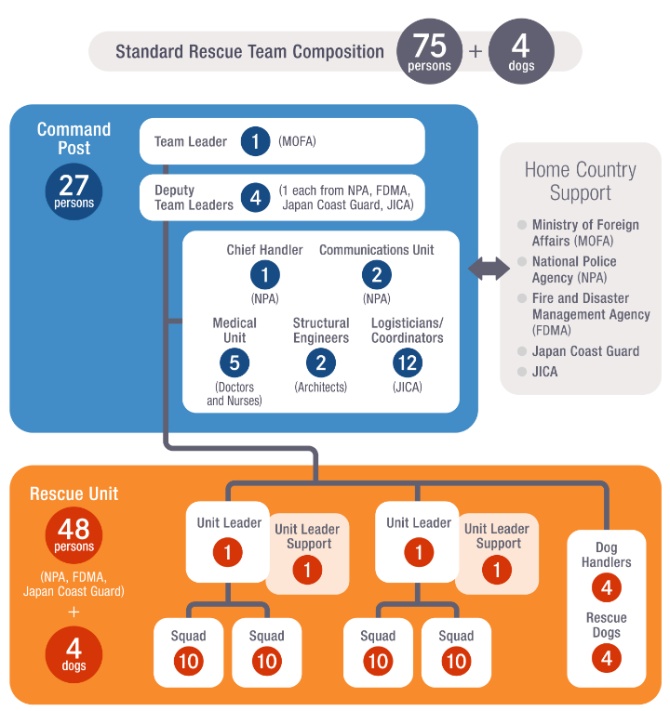
In November 2022, the JDR took the External Reclassification certification assessment administered by the International Search and Rescue Advisory Group (INSARAG), a network of international search and rescue teams. INSARAG was established in 1991 after the experience of the 1988 earthquake in Armenia, which suffered from a lack of coordination among rescue teams sent from various countries, thereby inflicting a heavy burden on the disaster-hit nation. The goal of the group is to enhance effective global search and rescue operations by establishing common regulations worldwide.
INSARAG’s accreditation system classifies the competence of each country’s international search and rescue team by operational capacity: Heavy, Medium, and Light. The accreditation is based on a rigorous assessment with each team’s capabilities evaluated on more than 170 checkpoints. Teams fail if they receive even one red mark out of the three-level evaluation system: green, yellow, and red. “If a team is certified as Heavy,” said Katsube, “it means that it is recognized as a highly competent team, capable of rapid deployment, self-sufficient operations, and advanced and safe rescue, as well as being capable of coordinating with the government of the affected country.”
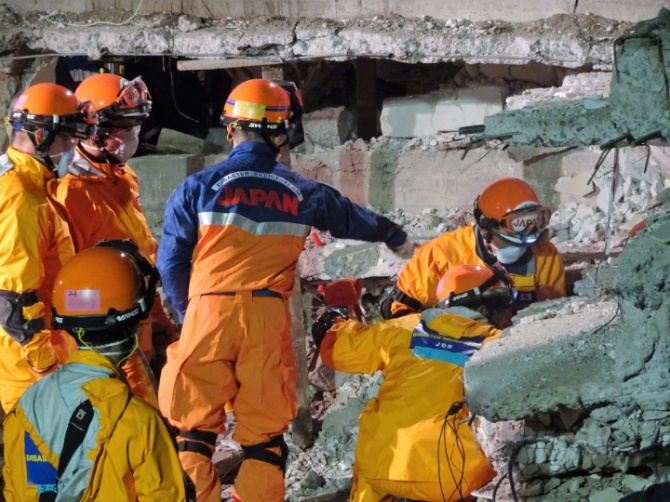
The JDR’s work on the site of the 2017 earthquake in central Mexico is one of 20 times it has been deployed overseas.
From 2005, when the certification system began, to October of 2022, more than 60 teams from nations around the world have taken it. The Japanese team was awarded the Heavy classification in its first IEC (INSARAG External Classification) in 2010, then again in 2015. As a result of delays caused by the COVID-19 pandemic, the team took its first accreditation in seven years for its second reclassification.
“IEC/IER is not only an opportunity for the JDR Rescue Team to confirm its technical capabilities,” said Katsube, who has been involved in the certification of many teams as a classifier. “It's also an opportunity for other teams to see whether we can be trusted to smoothly carry out international search and rescue operations. It is a test that we must never fail.”
The premise of the assessment was an earthquake event in the fictitious country of Trinia. Search and rescue operations needed to be conducted at six affected sites within 30 hours of arrival at the local airport. Two units had to engage in the search and rescue of victims at the sites which realistically resembled a disaster area, including collapsed buildings and debris. At Site 6, called “Bluebird Park,” for instance, the units were instructed to listen to witnesses about the possibility of park employees, parents and children being in the collapsed building, and enter the building with rescue dogs and tools like acoustic search devices. They were to search for and locate anyone who needed to be rescued as well as determine if a rescue could be carried out safely. They were also instructed to act quickly in case a rescue dog was hurt.
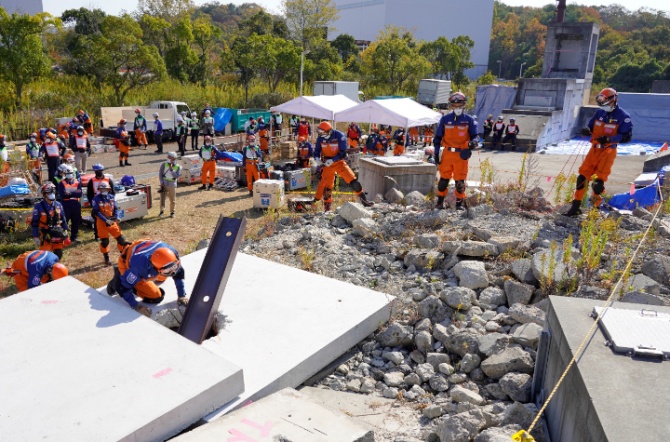
The simulated earthquake affected area at Site 6.
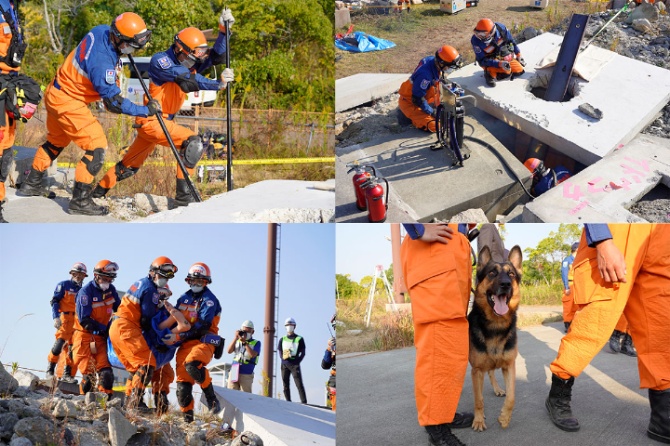
The assessment scenario: buildings in the square had collapsed and persons trapped in the debris had to be rescued.
JDR had received yellow verifications on four sections in its previous reclassification. This time, the team focused on raising their status through repeated practical training. “We focused in particular on thorough safety management,” said Katsube. “It’s a different environment from that in Japan, so we upgraded the system for monitoring the movement of the team members and increased the number of personnel in charge. This was to ensure safety not only at the rescue site but also at the base of operations and during transport.”
Logistical support for search and rescue sites is also a key factor. Thanks to the JICA logisticians affiliated with the Rescue Team, water and sanitation in the base where the rescuers were camped out were greatly improved.” Previously, team members maintained sanitary conditions by wiping their bodies with disposable wet towels. This time we were able to use a hot-water shower system using recycled wastewater technology developed by a Japanese company. We adopted this system to help personnel feel more comfortable even at disaster sites, where water use is usually limited.”
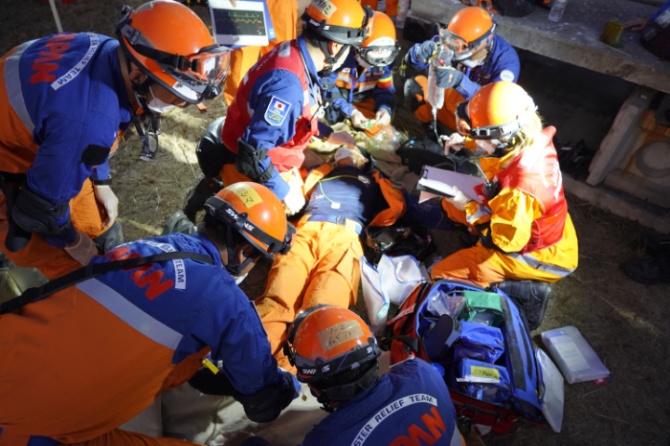
Various incidents that had been incorporated into the assessment had to be handled within a limited time. One of the scenarios included an injured team member.
The assessment included a scenario in which the Japanese team would enter the disaster area ahead of other teams. In this section, the ability to negotiate and coordinate the many incoming rescue teams that arrived later was put to the test.
“There are some affected countries that are unaware of INSARAG’s coordination mechanism,” said Katsube. “So we start by explaining the importance of coordination among the rescue teams in order to save more lives, and how we can play the role of coordinator. The coordinator is responsible for determining the methods and procedures for communicating information so that the teams that come in later can proceed smoothly with their relief activities. This reduces the burden on the affected countries.”
JDR improved its performance in all four of the previous yellow marks to green. The number of “best practices” rated by the evaluators was also the highest ever.
Katsube says that his continued work onsite on international emergency relief activities is his way of repaying the global support that Japan received after the Great East Japan Earthquake. “It’s important to obtain recertification,” he said. “But this only means that we have met the minimum standards for international deployment, and is not a promise that we can save lives. To be able to actually deploy and save lives, we must work tirelessly to maximize our capabilities. Disasters can strike at any time, so when we are called upon for assistance, we must be ready to quickly enter the area and save those under the rubble who are waiting for help. This is the way we can return the favor.”
Having achieved the Heavy reclassification, the JDR Rescue Team is expected to play an increasingly active role in the future. They will continue to take on the challenge of saving as many lives as possible.
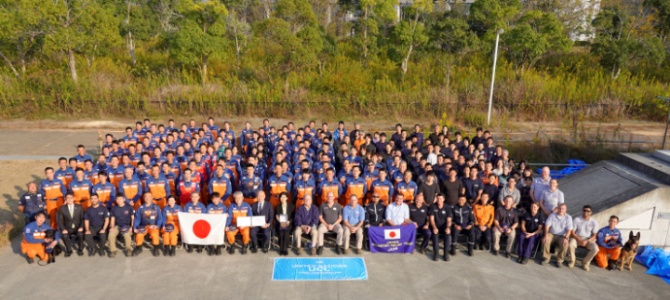
There were approximately 200 people, including instructors, evaluators, and administrators from overseas, on hand when the JDR participated in the certification assessment.
scroll